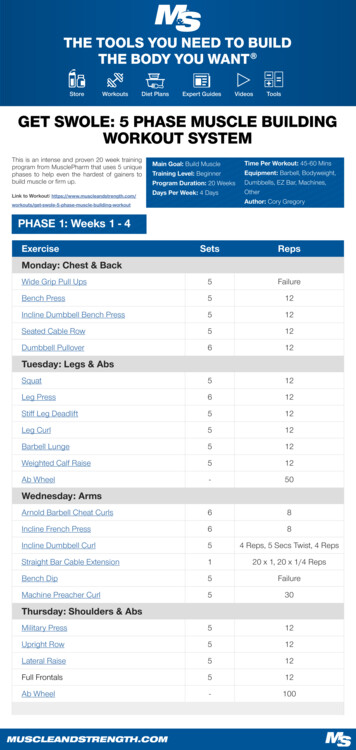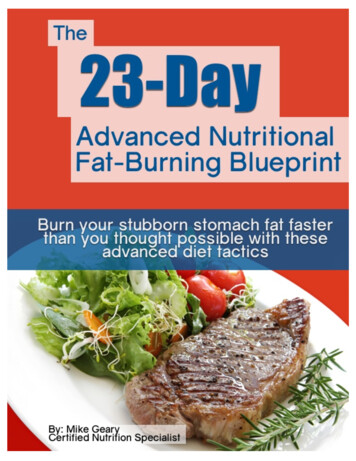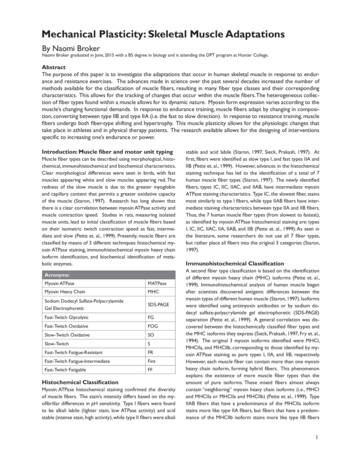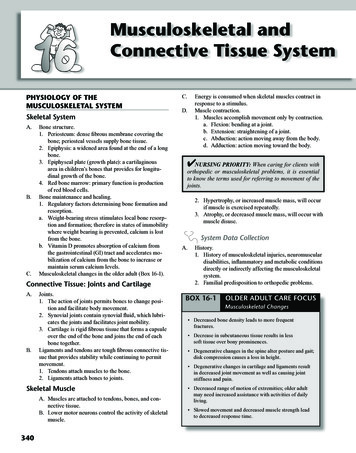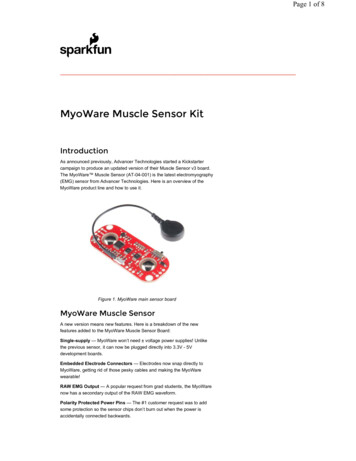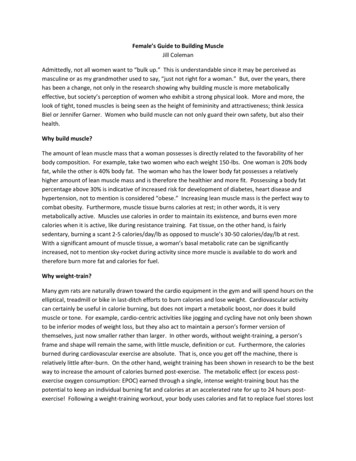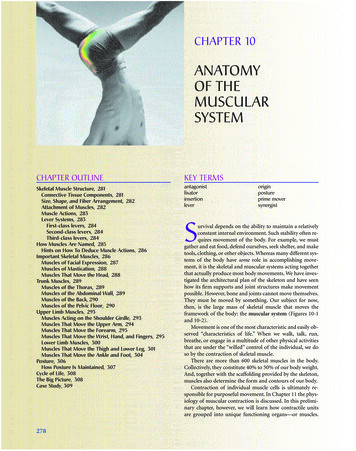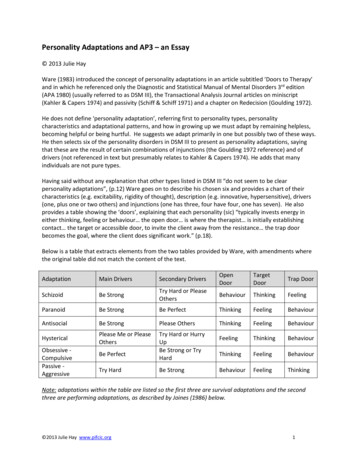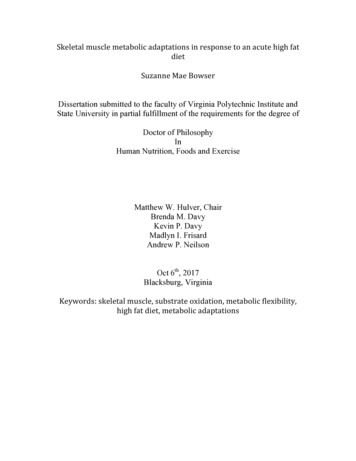
Transcription
Skeletal muscle metabolic adaptations in response to an acute high fatdietSuzanne Mae BowserDissertation submitted to the faculty of Virginia Polytechnic Institute andState University in partial fulfillment of the requirements for the degree ofDoctor of PhilosophyInHuman Nutrition, Foods and ExerciseMatthew W. Hulver, ChairBrenda M. DavyKevin P. DavyMadlyn I. FrisardAndrew P. NeilsonOct 6th, 2017Blacksburg, VirginiaKeywords: skeletal muscle, substrate oxidation, metabolic flexibility,high fat diet, metabolic adaptations
Skeletal muscle metabolic adaptations in response to an acute high fat dietSuzanne Mae BowserABSTRACTMacronutrient metabolism plays an essential role in the overall health of anindividual. Depending on a number of variables, for example, diet, fitness level, ormetabolic disease state, protein, carbohydrate and fat have varying capacities to beoxidized and balanced. Further, when analyzing the oxidation of carbohydrate andfat in the skeletal muscle specifically, carbohydrate balance happens quite rapidly,while fat balance does not. The ability of skeletal muscle to adapt and respond tovarious nutrient states is critical to maintaining healthy metabolic function. Habitualhigh fat intake has been associated with reduced oxidative capacity, insulinresistance, increased gut permeability, inflammation, and other risk factors oftenpreceding metabolic disease states. The disruption of gut function leads to gutpermeability and increases endotoxins released into circulation. Endotoxins havebeen shown to play an important role in obesity-related whole body and tissuespecific metabolic perturbations. Each of these disrupted metabolic processes isknown to associate with obesity, metabolic syndrome and diabetes. To date, limitedresearch has investigated the role of high fat diet on skeletal muscle substrateoxidation and its relationship to gut permeability and endotoxins. The purpose ofthis study was to determine the effects of an acute, five-day, isocaloric high fat diet(HFD) on skeletal muscle substrate metabolism in healthy non-obese humans. Anadditional purpose was to determine the effects of a HFD on gut permeability andblood endotoxins on healthy, non-obese, sedentary humans. Thirteen college age
males were fed a control diet for two weeks, followed by five days of an isocaloricHFD. To assess the effects of a HFD on skeletal muscle metabolic adaptability andpostprandial endotoxin levels, subjects underwent a high fat meal challenge beforeand after a HFD. Muscle biopsies were obtained; blood was collected; insulinsensitivity was assessed via intravenous glucose tolerance test; and intestinalpermeability was assessed via the four-sugar probe test before and after the HFD.Postprandial glucose oxidation and fatty acid oxidation in skeletal muscle increasedbefore the HFD intervention but was decreased after. Skeletal muscle in vitro assayof metabolic flexibility was significantly blunted following the HFD. Insulinsensitivity and intestinal permeability were not affected by HFD, but fastingendotoxin was significantly higher following the HFD. These findings demonstratethat in young, healthy males, following five days of an isocaloric high fat diet,skeletal muscle metabolic adaptation is robust. Additionally, increased fastingendotoxin independent of gut permeability changes are potentially a contributor tothe inflammatory state that disrupts substrate oxidation. These findings suggest thateven short-term changes in dietary fat consumption have profound effects onskeletal muscle substrate metabolism and fasting endotoxin levels, independent ofpositive energy balance and whole-body insulin sensitivity.
Skeletal muscle metabolic adaptations in response to an acute high fat dietSuzanne Mae BowserGENERAL ABSTRACTMacronutrients, namely carbohydrates, fats and protein, and the way they areutilized play an important role in the overall health of an individual. Many variablescome into play when considering the oxidization (or utilization) of eachmacronutrient, including, but not limited to diet, fitness level, and metabolic diseasestate. Skeletal muscle and its role in these processes is of special interest as it is thelargest insulin sensitive organ in the body. Its ability to adapt and respond tovarious nutrient states is critical to maintaining healthy metabolic function. Habitualhigh fat intake has been associated with insulin resistance, increased gutpermeability (increasing endotoxins, which are toxins released into circulation fromthe intestines), reduced oxidative capacity (ability to utilize macronutrients forenergy), and inflammation, all of which are risk factors that precede metabolicdisease states. To date, limited research has investigated the role of high fat diet onskeletal muscle oxidation of macronutrients and its relationship to what is going onin the gut, or intestines. The purpose of the study was to determine the effects of ashort term high fat diet (five days) on skeletal muscle in healthy, non-obese humans,and to determine the effects of this diet on gut permeability and endotoxins.Thirteen college-age males were fed a control diet for two weeks followed by fivedays of a high fat diet. Each diet had the same caloric content. Subjects underwent ahigh fat meal challenge before and after the diet to assess the effects of the diet onskeletal muscle adaptability and post meal endotoxin levels. Before and after the
high fat diet, muscle biopsies were obtained, blood was collected, insulin sensitivitywas assessed and gut permeability was measured. We found that skeletal musclemetabolic adaptation is robust. Additionally, increased fasting endotoxin changesare a possible contributor to the inflammatory state that disrupts macronutrientoxidation. Therefore, even short-term changes in dietary fat consumption haveprofound effects on skeletal muscle metabolism and fasting endotoxin levels,independent of positive energy balance and whole-body insulin sensitivity.
ACKNOWLEDGEMENTSMatt: Thank you, thank you, thank you! When I began my journey to work toward aPhD, I contacted many professors of other universities, who looked at my resumeand didn’t see the scientific background necessary to be successful. When I met withyou, you saw me, you saw potential and you saw experience in my life that couldcontribute to a successful obtaining of a PhD. For that, I am so grateful. Also, at timesI cursed your name for encouraging me to pursue the RD credentials, but I amgrateful that you recommended that path, as it has opened up doors andexperiences that have enriched my education. Thank you for your mentorship andyour confidence in me.Madlyn: Your guidance and direction with my 7 zillion questions has been greatlyappreciated. Thank you for taking your time to talk me through so much of theprocesses necessary to be a successful PhD student at Tech. Thank you for yourconstant support and for always making me feel like I am important.Ryan: How can I ever thank you enough for the countless hours you have taken tohelp me understand concepts and assays and even how to work with other peoplemore effectively. Your patience and confidence in me, and the time you have takenaway from your other duties to either simply listen or to read/edit a paper, write arecommendation or to direct me in some way was so helpful and so veryappreciated. Thank you.Drs. Davy: Kevin and Brenda, thank you for your support and the time you havetaken to guide me to becoming a successful PhD candidate, dietetic intern and PostDoc fellow. Thank you for your challenging questions and for giving me valuablevi
feedback throughout my time. I have also appreciated the way I have felt welcome inyour home. Kevin, thank you for helping me get scholarships and for yourwillingness to write recommendations for me.Andrew: Thank you for giving me the opportunity to work with you and your groupto collaborate and write my first –first author paper. J I valued your advice inwriting as well as all of the other details I had to learn by just attempting it for thefirst time. Thank you for your patience with that process and with teaching me thequick and dirty version of gut permeability your availability to assist me whenneeded was appreciated.Kris Osterberg and Nabil Boutagy: Thank you for doing so much of the groundwork of the ADA study, recruiting participants, screening them, and scheduling theappointments – your work, time and effort did not go unnoticed!!Past and present lab mates: Thank you not only for your friendship and makingthe lab a fun workplace, but also, I have learned so much from each of you. Thankyou for taking me under your wing and offering assistance and advice in themultiple times I have needed it.Mom, family, friends (my family away from home): None of you have everdoubted me or my ability to accomplish hard things. I could never describe howgrateful I am for your relentless support and encouragement. Mom, when I haveeven half as much confidence in myself as you have in me, I will move mountains.Katie, thank you for taking the role of big sister these past few years, even thoughyou are the baby!! Thank each one of you, and especially my nieces and nephewswho have a way of making me smile and laugh and feel like a million bucks!vii
ATTRIBUTIONSCHAPTER 2: LITERATURE REVIEWMatthew Hulver, PhD Madlyn Frisard, PhD and Suzanne Bowser conceived anddesigned the review; Ms. Bowser wrote the review; Dr. Hulver and Dr. Frisardedited the document.CHAPTER 5: SKELETAL MUSCLE METABOLIC ADAPTATIONS IN REPONSE TO ANACUTE HIGH FAT DIETMatthew Hulver, PhD was the principal investigator on the grant that funded theresearch. He oversaw the entire study. Kevin Davy, PhD, a co-investigator on theproject, was responsible for day to day operations in the clinical laboratory. BrendaDavy, PhD, RDN, a co-investigator on the project, was responsible for all aspects ofdietary control. Andrew Nielson, PhD a co-investigator on the project, wasresponsible for measures of gut permeability. Ryan McMillan, PhD, the studycoordinator, managed all aspects of scheduling, testing, sampling, and datacollection and oversaw all aspects of measurement of skeletal muscle. MadlynFrisard, PhD and the above mentioned personnel contributed to the design of thestudy and will co-author the manuscript. Suzanne Bowser wrote the manuscript andassisted Dr. McMillan in scheduling, testing, sampling, and data collection as well asin measurements of skeletal muscle.viii
TABLE OF CONTENTSABSTRACT . iiGENERAL ABSTRACT . ivACKNOWLEDGEMENTS . viATTRIBUTIONS . viiiTABLE OF CONTENTS . ixLIST OF FIGURES . xiLIST OF TABLES .xiiCHAPTER 1: INTRODUCTION . 1CHAPTER 2: LITERATURE REVIEW . 6INTRODUCTION . 6BACKGROUND . 8MACRONUTRIENT METABOLISM .11Protein balance and oxidation . 11CHO balance and oxidation . 12Fat balance and oxidation . 12Fat oxidation and fat balance in skeletal muscle . 16METABOLIC FLEXIBILITY .18GUT PERMEABILITY .22CONCLUSION .25REFERENCES .26CHAPTER 3: SPECIFIC AIMS . 34CHAPTER 4: RESEARCH DESIGN . 36CHAPTER 5: SKELETAL MUSCLE METABOLIC ADAPTATIONS IN REPONSE TOAN ACUTE HIGH FAT DIET . 39ABSTRACT .39INTRODUCTION .41METHODS.43Participants . 43Experimental design . 43Controlled Feeding Procedures . 44High Fat Meal Challenge . 45Measurements and Procedures . 46Statistics . 54RESULTS .55Participant characteristics . 55Diet . 55Whole body measurements . 56Substrate metabolism . 57Pyruvate dehydrogenase complex . 59Adapters and Non-Adapters in FAO and GO. 60DISCUSSION .63ix
Further directions . 69Conclusion . 69FIGURE LEGENDS .70REFERENCES .71CHAPTER 6: CONCLUSIONS/FUTURE DIRECTIONS . 75x
LIST OF FIGURESCHAPTER 2: LITERATURE REVIEWFigure 1: Schematic of metabolically healthy individual . .2Figure 2: Schematic of metabolically diseased individual .3Figure 3: Metabolic flexibility . .19CHAPTER 5: SKELETAL MUSCLE METABOLIC ADAPTATIONS IN RESPONSE TOAN ACUTE HIGH FAT DIETFigure 1: Schematic of research design .44Figure 2: Meal challenge blood measures .57Figure 3: Substrate oxidation .59Figure 4: Pyruvate dehydrogenase complex .60Figure 5: Fatty acid oxidation adaptation . 61Figure 6: Glucose oxidation adaptation .62xi
LIST OF TABLESCHAPTER 5: SKELETAL MUSCLE METABOLIC ADAPTATIONS IN RESPONSE TOAN ACUTE HIGH FAT DIETTable 1: MS/MS Transitions for detection of sugar probes .49Table 2: Participant characteristics .55Table 3: Diet mean energy and macronutrient content .55Table 4: Whole body fasting measures .56Table 5: Substrate Metabolism 58xii
CHAPTER 1: INTRODUCTIONObesity and other metabolic diseases are major contributors to serious healthconditions among Americans. The prevalence of obesity in the United States and globallyhas grown rapidly in the last three decades. In 2014 more than one-third (27.9%) of USadults met the definition of obesity (Body Mass Index of greater than 30kg/m2)1. Likewise,according to the 2014 National Diabetes Statistics Report, the prevalence of Type 2Diabetes mellitus (T2DM) is on the rise. In 2012, 9.3% of the population had T2DM,accounting for 29.1 million people. The prevalence for adults age 20 and older in 2012 was12.3%. Diabetes is the 7th leading cause of death within the United States in 20132. In orderto better understand T2DM, obesity and other metabolic diseases, research into themechanisms contributing to or priming the body for these conditions is imperative.While overall health is multi-factorial, a number of characteristics of metabolichealth and likewise, metabolic disease, have been elucidated. Below are two simplifieddiagrams illustrating in Figure 1, a metabolically healthy individual and in Figure 2, ametabolically diseased individual. These are certainly not exhaustive in nature; howeverprovide an exemplary of disturbances that occur as a result of consuming a habitual highfat diet.1
Figure 1. Schematic of Metabolically Healthy IndividualFigure 1, depicts the processes in a metabolically healthy individual. Whenconsuming a well-balanced diet, the gut maintains integrity and proper function of itsbarrier, releasing little to no endotoxins into circulation. The skeletal muscle responds tosubstrates available and oxidation of the most predominant macronutrient is upregulated.Skeletal muscle is metabolically flexible, and the processes are highly functioning.However, in figure 2, which depicts a metabolically diseased individual, theseprocesses are disrupted. A high fat diet disrupts gut barrier function, increasing gutpermeability, leading to endotoxins being released into circulation. Low-grade elevation ofplasma endotoxins, metabolic endotoxemia, activates toll-like receptor-4 (TLR4), which in2
turn causes an increase in TLR4 expression in skeletal muscle. An increased TLR4 presencein skeletal muscle favors glucose oxidation (GO) regardless of the substrate that isavailable. Likewise, this favoring of GO, inhibits fatty acid oxidation (FAO). These disruptedprocesses lead to a proinflammatory state and dysregulated metabolism as seen in obesity,Type 2 Diabetes and insulin resistance.Figure 2. Schematic of Metabolically Diseased IndividualThe complexity of substrate oxidation in the presence of different dietarycompositions has been connected to metabolic disease states including obesity, T2DM and3
metabolic syndrome3–7. While protein oxidation remains relatively stable regardless of thecomposition of the meal, carbohydrate and fat oxidation are shown to fluctuate givendifferent percentages of macronutrients in the diet8. The consequences of the alterableoxidation and utilization of these substrates has been a subject of research as the growingepidemic of obesity and T2DM continues to plague people of the world.Skeletal muscle is not only a primary site of glucose oxidation9, but also makessubstantial contributions to whole body fat oxidation10. Habitual as well as acute diet areassociated with varying degrees of glucose and fat oxidation within the skeletal muscle. Theability of skeletal muscle to utilize and adapt to available substrates is termed metabolicflexibility11. Linked to the variable oxidation rates among different diet compositions,metabolic flexibility (or inflexibility) in the skeletal muscle has been associated withdisease states, such as insulin resistance and obesity12. What is unknown is if metabolicinflexibility in skeletal muscle precedes disease states or if disease states cause metabolicinflexibility. Further research is needed to further elucidate this question and tounderstand disruptions in substrate oxidation and metabolic inflexibility when participantsare subjected to a high fat diet.Gut permeability, which is the control of substances passing through the intestinalwall, has been associated with disease states mentioned above. Dietetic factors have beenshown to increase gut permeability13. Diet has also been linked to an increased presence ofendotoxins in the blood14. The association of high fat diet and endotoxemia originatingfrom the gut has been a topic of great interest. Further research is needed in order tounderstand the contributing factors of metabolic endotoxemia.4
A variety of factors must be considered when determining substrate metabolism inskeletal muscle and its association to disease states. An additional tool that can provevaluable is categorizing metabolic phenotypes by classifying groups of adapters versusnon-adapters; adaptation to which variable depends on the research question to beanswered. For example, when analyzing fatty acid oxidation, the adapters are in referenceto those who adapted to high fat feeding by increasing fatty acid oxidation, whereas thenon-adapters are those who did not. By characterizing, we may be able to potentiallyidentify factors that contribute to the onset and/or progression of metabolic disease in thecontext of high fat feeding.5
CHAPTER 2: LITERATURE REVIEWINTRODUCTIONOnly within the last 60 years has obesity become a widespread issue of publicconcern. While there are historic artifacts of Stone Age Venus and paintings of Chineseemperors who would be considered obese, and ancient scholars and doctors who tiedobesity to health (or lack thereof), the widespread prevalence and resulting epidemic ofobesity is fairly recent. According to the most recent (2011-2014) United States NationalHealth and Nutrition Examination Survey (NHANES) data, nearly 40% of Americans areobese (BMI greater than or equal to 30kg/m2)1, spanning across socioeconomic classes,age, race, and gender. Annually, the estimated medical costs of obesity are nearly 150billion15. Because of the considerable effect of obesity on chronic disease, an immenseamount of research has gone into understanding its impact. Research shows that lifeexpectancy can decrease anywhere from 3 to 14 years for obese individuals, noting that asBMI increases, relative risk of mortality increases16,17. Trends show the potential forchildren born in this generation to have a shorter life expectancy than those of theirparents; the first time this effect is realized18. Risk of T2DM, cardiovascular disease, cancer,becoming and remaining disabled, and psychological disorders each have a positivecorrelation with obesity19–21. Obesity is a risk factor for 7 of the 10 leading causes of deathin the United States22. Obesity has not only become medicalized itself, but its closeassociation with other risk factors and chronic diseases make it a significant issue of publicconcern.Although earlier research exists on obesity and its relationship to the developmentof chronic disease, in the 1960’s and 70’s, there began to be a concentrated effort to define6
the causes, risks, mechanisms and anything more that could be a contributor to obesity.Much of the research was focused on determining body weight regulation and itsconnection to the development of chronic disease. Macronutrients have been a primaryfocus of this discussion.An extensive amount of resources have been committed to understanding obesityand chronic disease, but what do we really know about the effects of macronutrientmetabolism on health? Research is prevalent, but a concrete understanding andcomprehensive knowledge is lacking in many areas of this important issue. There are manyschools of thought in the highly debated and controversial topic of the primary dietaryfactors affecting cardiovascular disease, T2DM and obesity. However, in the 1950s-1960s,there were two main areas of focus, 1) fat was the main dietary influence of coronary heartdisease (CHD) or 2) sugar was a more significant contributor to the associated risks of CHD.Studies examining the role of fat oxidation and balance on metabolism and theregulation of body weight are interspersed in the literature, but due to observedassociations between sugar intake and the rise in obesity, the study on CHO load and itseffects on obesity has been quite popular. Recommendations from the United StatesDepartment of Agriculture, as early as the 1980s, were made to decrease fat consumption,which resulted in an unintended increased refined sugar and CHO consumption23. Theguidelines, even from 1980, suggest an increase in complex carbohydrates, meaningvegetables, fruits and whole grains. However, the food industry’s marketing response wasthe low fat craze, which incidentally increased intake of refined sugar and simplecarbohydrates. Body weight, T2DM, and other chronic diseases among Americanscontinued to rise.7
This review is intended to examine what is known about macronutrient metabolismand its effects on health. The Randle cycle and substrate metabolism and its in relation toobesity and chronic disease with a concentration on skeletal muscle will be discussed. Morespecifically, whole body and skeletal muscle metabolic flexibility, in the context of high fatfeeding, will be examined, further exploring fat balance and fat oxidation in skeletal muscle.BACKGROUNDThe glucose fatty acid cycle, or Randle cycle, named for Sir Philip Randle (1963), isfoundational to our understanding of macronutrient metabolism and energy homeostasis.In his work, he and his colleagues detailed the mechanisms behind the ability of cardiacand skeletal muscle to shift between carbohydrate (CHO) and fat use and storage,depending on substrate availability. As the theory was conceived, Randle and his groupused the long-standing ideas that substrates compete for respiration. For example, earlyresearch in the 1930s indicated competition between amino acids and glucose when thedeamination of amino acids in kidney tissue was inhibited by oxidizable substrates24, andin the perfusate of dog heart-lung preparation, the presence of carbohydrates inhibitketone utilization25. Further work in the early 1960s reported inhibition of glucoseutilization and oxidation by acetoacetate and palmitate26,27. These and other studies ledRandle and his group to devise the theory of the glucose fatty acid cycle. The theoryincluded a few key components; the first of those components, simply stated, is that therelationship of glucose and fatty acid metabolism is reciprocal, and not dependent, meaningthat elevated glucose concentrations stimulate insulin secretion and suppress fatty acidrelease from adipose tissue. Secondly, fatty acids and ketone bodies that are released into8
circulation in times of disease or starvation inhibit the breakdown of glucose in muscle.Elevated fatty acid concentrations in circulation are usually indicative of low glucose andinsulin, thereby becoming the primary fuel source of skeletal muscle, which reducesglucose uptake and oxidation. The purpose of the glucose-fatty acid cycle theory, which isnot a “cycle” at all, was to explain the biochemical mechanism of thecompetition/interaction of glucose and fatty acid oxidation.Researchers have continually investigated the Randle cycle and its constituents tofurther understand mechanisms responsible for the development of insulin resistance,T2DM, and obesity, which are clearly associated with altered macronutrient metabolism. Inorder to obtain a clearer understanding of their mechanisms of action, methods ofmeasuring macronutrients and specific hormones, such as insulin, have been developed,improved and reinvented. Reubin Andres and his group were first to describe the methodsof the hyperglycemic and euglycemic clamps and their use for measuring glucose andinsulin sensitivity28. The
Skeletal muscle metabolic adaptations in response to an acute high fat diet Suzanne Mae Bowser ABSTRACT Macronutrient metabolism plays an essential role in the overall health of an individual. Depending on a number of variables, for example, diet, fitness level, or metabolic disease state, pr

